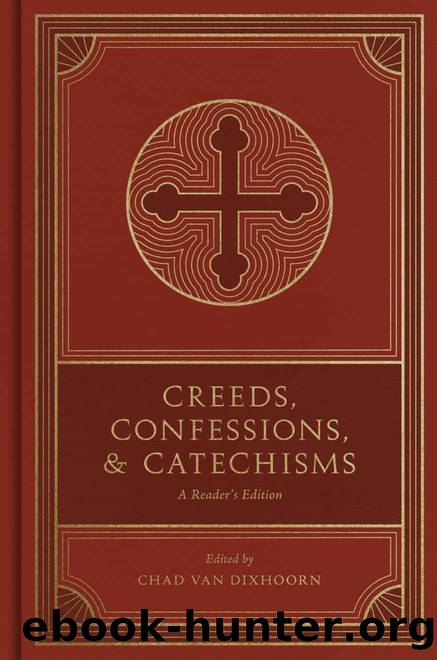Creeds, Confessions, and Catechisms by Chad Van Dixhoorn

Author:Chad Van Dixhoorn [Chad Van Dixhoorn]
Language: eng
Format: epub
Publisher: Crossway
Published: 2022-05-15T00:00:00+00:00
The Heidelberg Catechism
Introduction
The chief influence in the development of the Heidelberg Catechism was Zacharias Ursinus. A new recruit at the University of Heidelberg (in modern-day Germany), the twenty-nine-year-old professor of theology was a leading figure in the universityâs golden age as a center for training ministers for the Protestant church. Ursinusâs catechism, completed in 1563, was his most famous work. It was quickly translated into various languages and became a favorite among the Reformed. When the Synod of Dort approved the catechism in 1619, it was assured a special place among churches in the continental Reformed tradition.
The preface to the catechism (Questions 1 and 2) frames the discussion of the faith in terms of gospel comfort in the face of sin and suffering. In words that have thrilled generations of believers, the catechism offers a vocabulary to express confidence in Christ: âI am not my own, but belongâbody and soul, in life and in deathâto my faithful Savior, Jesus Christ.â A conversation follows, all of it in question-and-answer form, organized under the headings of guilt, grace, and gratitude.
Questions 3â11 speak of our sin and the misery that accompanies a failure to keep Godâs lawâa law summarized in the two great commandments of Matthew 22:34â40. The catechism concludes that the gravity of our sin and the pure severity of Godâs justice have left us in a desperate place.
Questions 12â85 then offer welcome relief. The catechism employs the Apostlesâ Creed to introduce our triune God and then trace the plan of salvation. Particularly useful is an explanation of the reason for the incarnation. With this catechism in hand, every believer is helped to answer the question, why did God become man? As expected in an exposition of the creed, this section also discusses the doctrine of the church (briefly) and the sacraments (at length).
The final questions, 86â129, ask how we might express our thankfulness for the grace of God in delivering us from our misery. The catechism colors in the details of the Christian life using the outlines provided by the Ten Commandments and the Lordâs Prayer, considering one precept or petition at a time. Here as elsewhere, the catechism groups questions into âLordâs Days,â coherent units that Reformed Christians were expected to consider on a weekly basis, often in an afternoon worship service. With fifty-two Lordâs Days, church leaders could offer a summary of the whole of theology in one year, thus grounding believers in their understanding not only of the Bible itself but of the Bibleâs central themes as well.
Download
This site does not store any files on its server. We only index and link to content provided by other sites. Please contact the content providers to delete copyright contents if any and email us, we'll remove relevant links or contents immediately.
| Book of Common Prayer | Catechisms |
| Devotionals | Hymns & Hymnals |
| Meditations | Monasticism & Asceticism |
| Pentecostal & Charismatic | Prayerbooks |
| Rites & Ceremonies | Sacraments |
The Secret Power of Speaking God's Word by Joyce Meyer(3072)
More Language of Letting Go: 366 New Daily Meditations by Melody Beattie(3004)
To Light a Sacred Flame by Silver RavenWolf(2791)
How Proust Can Change Your Life by Alain De Botton(2772)
Anxious for Nothing by Max Lucado(1946)
A TIME TO KEEP SILENCE by Patrick Leigh Fermor(1882)
Curse Tablets and Binding Spells from the Ancient World by Gager John G.;(1853)
The Gnostic Gospel of St. Thomas by Tau Malachi(1769)
7 Secrets of Divine Mercy by Vinny Flynn(1711)
all by Unknown Author(1663)
365 Tao: Daily Meditations by Ming-Dao Deng(1602)
From Good Goddess to Vestal Virgins: Sex and Category in Roman Religion by Ariadne Staples(1553)
100 Days of Thanks by Thomas Nelson(1545)
To Ride a Silver Broomstick by Silver RavenWolf(1538)
Anam Cara by John O'Donohue(1533)
The Fasting Edge by Jentezen Franklin(1518)
To Stir a Magick Cauldron by Silver RavenWolf(1505)
The Sacred Enneagram by Christopher L. Heuertz(1417)
New Morning Mercies by Paul David Tripp(1371)
